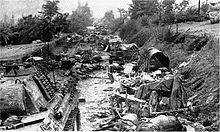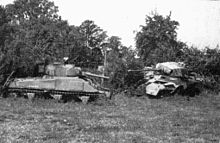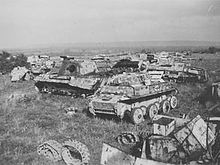Hill 262
During the night of 19 August, two battle groups of the Polish 1st Armoured Division (Major-General Stanisław Maczek) had established themselves in the mouth of the Falaise pocket on and around the northernmost of the two peaks of Mont Ormel ridge.Lacking the fighting power to close the corridor, the Poles directed constant and accurate artillery fire on German units retreating from the pocket, causing heavy casualties.The Poles were relieved by the Canadian Grenadier Guards shortly after noon; their stand had ensured the closure of the Falaise pocket and the collapse of the German position in Normandy.[8] Although intended only to cut a corridor through to Brittany to emerge from the bocage,[9] the offensive caused a collapse of the German position opposite the American sector when Generalfeldmarschall Günther von Kluge's Army Group B was slow to withdraw and expended many of its remaining effective formations in the Operation Lüttich counter-offensive.[19][20][nb 3] Facing determined German resistance and with Koszutski's battlegroup having "gone astray" and needing to be rescued, the division had not yet taken Chambois, Coudehard, or the Mont Ormel ridge.[27][28] During the day an armoured column from the 2nd Panzer Division broke through the Canadians in St Lambert, capturing half the village and maintaining an open road for six hours until being forced out.[32] Viewing the feature on an Allied map, Maczek commented that it resembled a caveman's club with two bulbous heads; the Poles nicknamed it the Maczuga, Polish for "mace".[16] Shortly after noon on 19 August, Battlegroup Zgorzelski (the 1st Armoured Regiment, 9th Infantry Battalion, and a company of anti-tank guns) made a thrust towards Coudehard and the Mont Ormel ridge.[32] While part of the battlegroup remained in Coudehard, two companies of the Polish Highland (Podhalian) Battalion led the assault up the north peak, followed by the squadrons of the 1st Armoured Regiment (Lieutenant-Colonel Aleksander Stefanowicz [pl]) who picked their way up a narrow, winding track.[31][36] The victory was hard-won over a period of a few hours; the Germans, despite being "shocked" to discover that Point 262N was in Polish hands, quickly responded with a bombardment from Nebelwerfer and anti-tank guns.[42] Field Marshal Walther Model, who on succeeding von Kluge two days earlier had authorised a general withdrawal,[4] was well aware of the need to remove the "cork"[38] from the bottle containing the 7th Army.[43] From within the pocket, German formations seeking an escape route were filtering through gaps in the Allied lines between Trun and Chambois,[nb 9] heading towards the ridge from the west.[38] A number of columns moving down from the northeast that included tanks and self-propelled artillery were subjected to an hour-long bombardment from the 1st Armoured Regiment's 3rd Squadron, breaking them up and scattering their infantry.[43] Having spotted German tank movements towards a nearby height, Point 239 (roughly 3 kilometres (1.9 mi) north of the ridge[6]), an attack was planned to take this feature and provide a buffer for the Poles' northern positions around the Zameczek.[43] At one point during the day[nb 10] a Panther tank of the 2nd SS Panzer Division worked its way onto the height and, at a range of 1,400 metres (1,500 yd), picked off five Shermans of the 1st Armoured Regiment's 3rd Squadron.Although the infantry and armour closing in on the Polish positions were eventually repulsed, with a large number of prisoners being taken and artillery again causing significant casualties,[44][46] the Poles were being gradually pushed back.Earlier in the day, Simonds had ordered his troops to "make every effort" to reach the Poles isolated on Hill 262,[52] but at "sacrificial" cost the remnants of the 9th SS Panzer and 3rd Parachute Divisions had succeeded in preventing the Canadians from intervening.[11][53] Dangerously low on supplies and unable to evacuate their prisoners or the wounded of both sides—many of whom received further injuries from the unremitting hail of mortar bombs—the Poles had hoped to see the Canadian 4th Armoured Division coming to their rescue by evening.Fighting died down and was sporadic throughout the hours of darkness; after the brutality of the day's combat both sides avoided contact although frequent Polish artillery strikes continued to harass German forces retreating from the sector.[58] Moving up from Chambois, the Polish 1st Armoured Division's reconnaissance regiment made an attempt to reach their comrades on Point 262N but was mistakenly fired upon by the ridge's defenders.[62] Marking the occasion, former President of the United States Dwight D. Eisenhower commented that "no other battlefield presented such a horrible sight of death, hell, and total destruction.








Operation TractablePolandGermanyStanisław MaczekWalter ModelOperation OverlordAtlantic WallBodyguardFortitudeZeppelinTitanicTaxable, Glimmer & Big DrumCombined Bomber OffensivePointblankTransport PlanPostage AbleTarbrushFabiusCaen canal and Orne river bridgesMerville BatteryMallardAmerican SectorAlbanyBostonChicagoDetroitElmiraNormandy landingsPointe du HocGambitPort-en-BessinAmericanOperation ChastityBritishMulberryBrécourt ManorGraignesLa Haye-du-PuitsSaint-LôCarentanHill 30CherbourgBrévilleVillers-BocageLe Mesnil-PatryNormandy massacresArdenne AbbeyDouvresMartletWindsorCharnwoodJupiter2nd OdonAtlanticGoodwoodVerrières RidgeSpringBluecoatTotalizeHill 140LüttichTractableChamboisFalaiseSaint-MaloMantes-GassicourtLa RochelleUshantLa CainePierres NoiresAudierne BayJedburghDingsonSamwestCooneyBulbasketHoundsworthLoytonKiplingDragoonWallace & HardyCemeteriesCoudehardNormandyBattle of FalaiseNormandy CampaignSecond World WarOperation CobraRiver Seine7th Army5th Panzer ArmyFalaise pocketGeneralfeldmarschall1st Armoured DivisionCanadian Grenadier GuardsOperation TotalizeLieutenant GeneralOmar BradleyBrittanybocageGünther von KlugeArmy Group BOperation LüttichBernard MontgomeryThird U.S. ArmyGeorge PattonSecond ArmyFirst Canadian ArmyHarry CrerarLieutenant-GeneralGuy SimondsII Canadian CorpsCintheaux4th Canadian1st PolishbattlegroupsMotorised infantry90th Infantry DivisionChampeaux4th Canadian Armoured DivisionSt LambertRiver DivesMont OrmelVimoutiersPolish1st Armoured Regiment